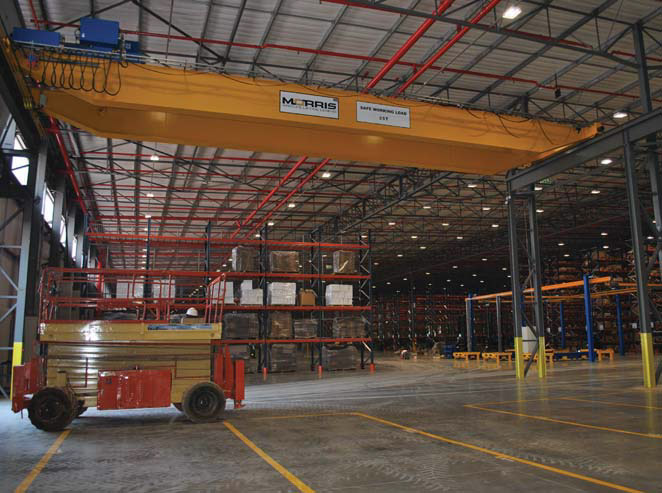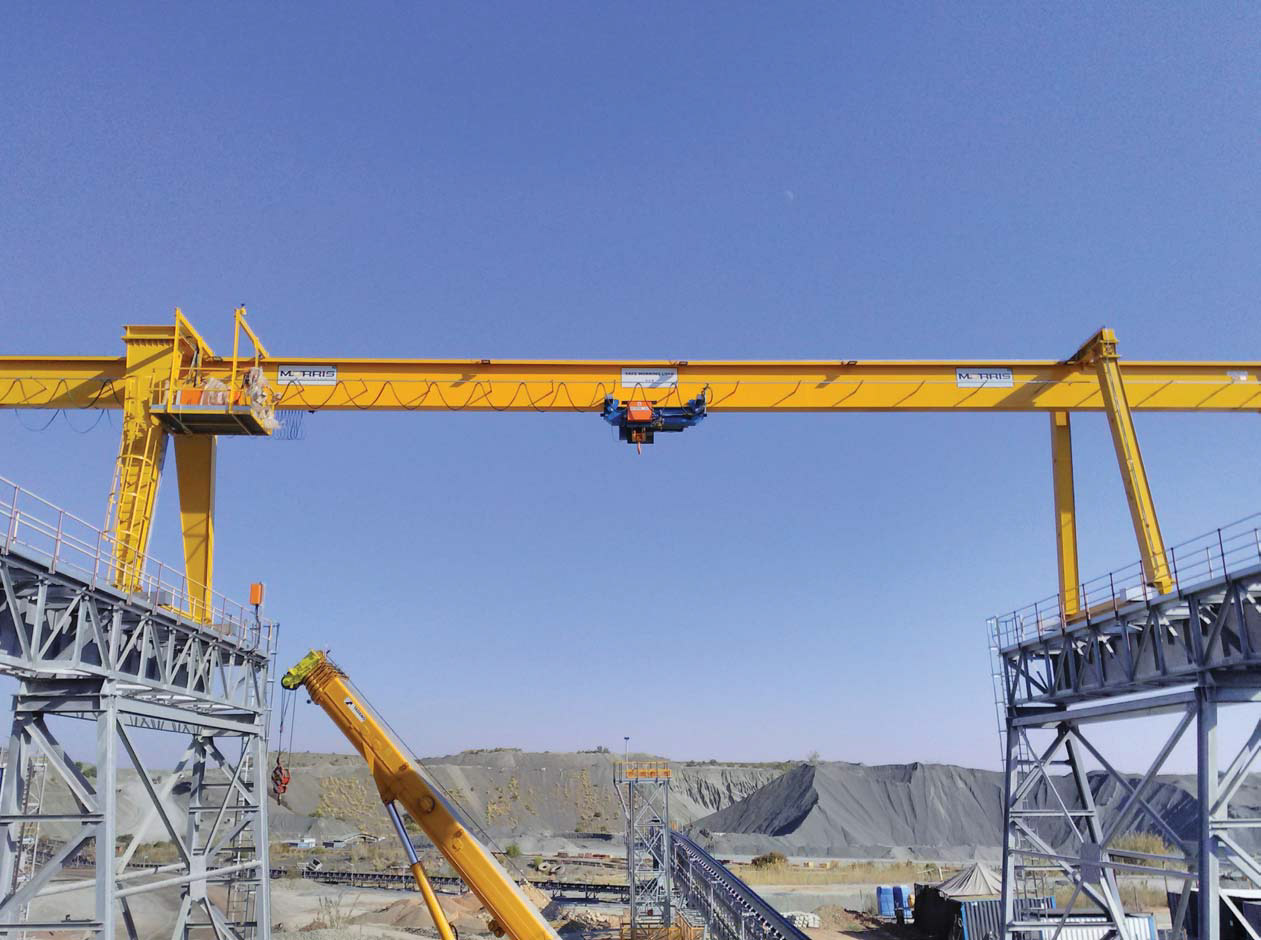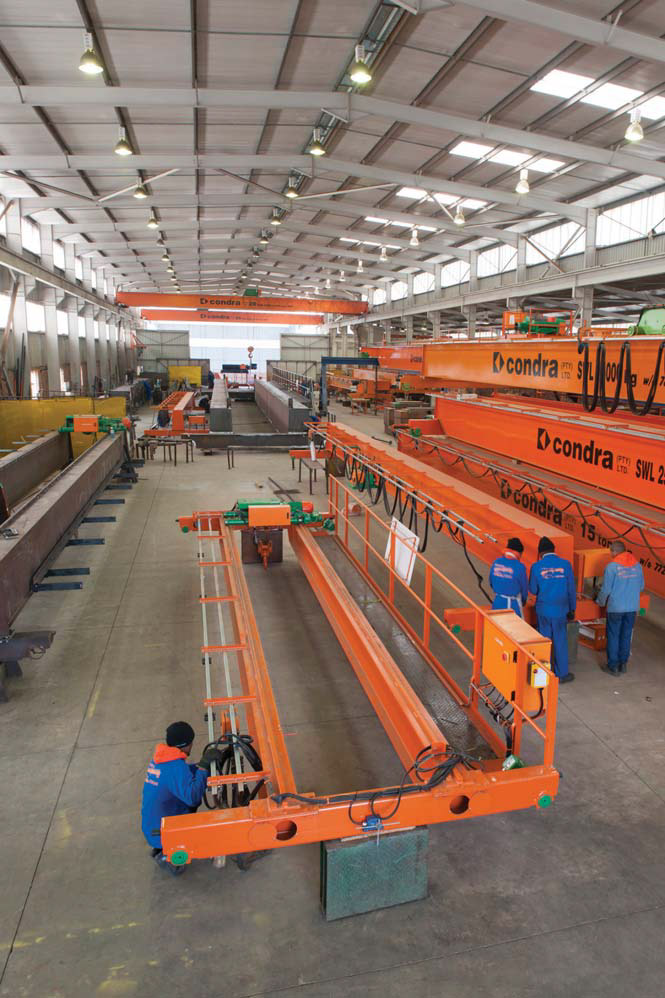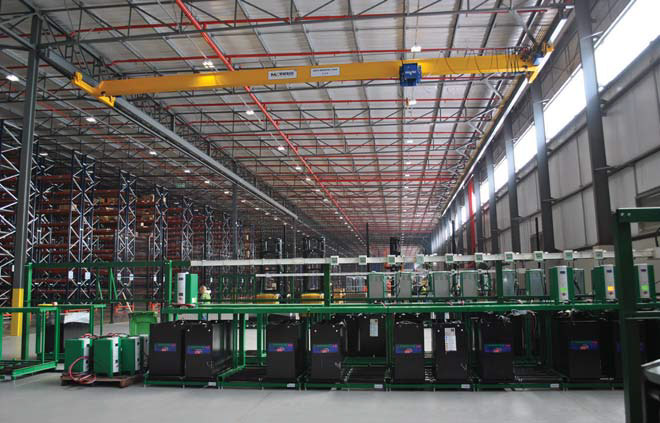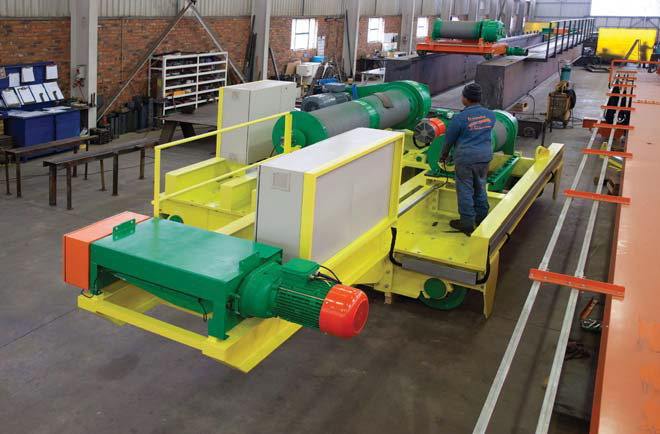Mixed Growth
10 May 2019Africa’s manufacturing sector may have previously gone through tumultuous times, but with recovering global commodity prices the sector is set to register growth that will fuel increased demand for various load lifting equipment designed to maximize quality production and ensure high level material handling processes. Shem Oirere reports.
According to the African Centre for Economic Transformation (ACET), the average share of manufacturing in the continent’s overall economy slumped by 7% between 1975 and 2015, but “production has nearly doubled from $85 billion in 2000 to more than $160 billion in 2015.”
It is estimated that Africa’s manufacturing sector has been growing at an annual rate of 3.5%, despite different countries in the continent exhibiting unique growth trends, which could have a direct effect on the region’s demand for cranes and hoists— especially for key industries such as cement, metal processing, mining and chemicals. Indeed, the African Development Bank cites manufacturing in West Africa, which has the lowest share in the sub region’s gross domestic product (GDP) compared to other sub-regions in the continent except for Côte d’Ivoire, where the sector contributed about 18% to the country’s economy in 2017.
The bank says manufacturing in the sub-region “is confined to light industry processing primary products and producing consumer goods”, which probably explains why uptake of heavy overhead lifting equipment by industries is still low compared to Southern Africa and other developed markets such as Europe, Asia and America.
“The West African market for hoists along with requirements for lifting equipment in general remains somewhat behind more developed parts of the world,” says John Traynor, managing director at Paterson Simons, a leading market player in West Africa which supplies and installs chain hoists, wire rope hoists and complete cranes such as single or double girder and goliath.
This equipment, Traynor says, comes with “varying degrees of sophistication such as operator aids like anti-collision, load control or Ex-protection, depending on the application.”
But some specific manufacturing industries such as cement, which relies on specialised heavy-duty overhead lifting equipment, has recorded notable growth especially in East Africa where production figures reached 14.4m tons in 2017 with projections the volumes could spike to 22.2m tons by 2023 according to industry reports. Elsewhere in South Africa, the country’s steel industry body, Steel and Engineering Federation of Southern Africa (Seifsa) says the manufacturing of metal is expected to post 1.1% growth in 2018 after the impressive 2.7% reported in 2017. This is likely to sustain demand for heavy overhead lifting equipment associated with the industry.
“Despite the current potential to improve on margins in the metals and engineering sector being fragile due to domestic headwinds, all indications are that the sector will record another increase in growth during 2018, barring any major disruptions to production,” said SEIFSA chief economist Michael Ade State at the launch of the Metals and Engineering Sector Report for 2018 to 2019.
The fastest growing segment of Africa’s lifting industry is the service and maintenance component with more customers increasingly asking their suppliers for more “servicing, repairing, modifying and load testing of all models of cranes and hoists” according to Emil Berning, director of Industrial Cranes & Industrial Service at Konecranes South Africa.
He said the tendency among consumers of lifting equipment in the sub-Saharan Africa is to “secure long term major service contracts for all types of cranes and hoists.” However, a major constraint in the growth of the service and maintenance of crane and hoist market remains to be the long-term high cost for project owners especially those who rely on imported equipment.
“Service and maintenance is of paramount importance in any working environment be it mining or manufacturing,” says Marc Kleiner, managing director of South Africa-based Condra Cranes and Hoists.
“In such working environments, if you are not moving products in the production process then you have a problem. But for the crane/hoist to move the products you need people to provide the necessary service and maintenance for the equipment, which actually enables the industrialisation to create more job opportunities,” he says.
But the service and maintenance component of the lifting equipment costs impacts on the long-term cost of cranes and hoists, depending on whether the products are sourced locally or imported.
“The biggest challenge in reducing the short- and long-term cost of lifting equipment involves foreign suppliers imposing rigid conditions such as use of such company’s spare parts and the supplier’s own service and maintenance crew.
“This costs much more in the long term for lifting equipment when one factors in the cost of importing the spare part and flying in technical staff for servicing and maintenance of the equipment,” says Kleiner.
For Morris Material Handling Pty Ltd, the service and maintenance contracts for the company’s cranes and hoists are carried out by Crane Aid, a division within Morris.
“This is often requested using their nearest branch where full service back up support, crane refurbishment and modernisation packages are offered,” says Daniela Jones, marketing coordinator at Morris Material Handling SA (Pty) Ltd, Southern Africa’s largest crane company associated with the manufacture and supply of electric overhead travelling cranes, portal cranes, wire rope hoists, jib cranes, chain hoists and lifting tackle.
She adds that Morris has “designed overhead cranes for all kinds of set-ups, and different components can be swapped out or engineered to improve its capacity and performance” during the servicing and maintenance of the equipment.
“Each overhead crane is carefully designed and engineered for a specific purpose or application to suit a business’ material handling needs,” she says.
Despite the level of electrification in Africa being low compared to developed markets such as Europe and Asia, the uptake of electric-driven lifting equipment across the continent has dominated the cranes and hoist market compared to manual solutions.
For the West African market, Traynor says, there is scope for both electric and manual hoist solutions although for Paterson Simons there is a bias towards electric overhead lifting equipment because of what he terms as the company’s “long established business of serving the mining community hence the preference for the more sophisticated end of the market looking for larger permanently situated cranes.”
“Manual hoists have a role to play particularly around complex process plants where maintenance access is tight and agile solutions for hoisting smaller components is required,” Traynor adds.
He says for larger installations, particularly around heavy equipment workshops “Konecranes Electric CXT wire rope hoists are popular with our customers because of their ease of use, strong build quality, long rope life and trouble-free performance.”
However, Traynor observes: “It is still not uncommon in some industries to see manual labour being used where mechanised lifting equipment would clearly be safer and arguably more efficient.”
Across south, west and east Africa, the increasing demand from the mining industry continues to impact the growth of the hoist market although it is not immediately clear what share of the lifting equipment market the extraction of minerals, oil and gas commands in these sub-regions.
In 2018 for example, Stats Statistics South Africa, the country’s national statistical service, says mining had a lacklustre year after production fell by 1.6% down from the 3.9% it achieved in 2017, with the largest drag observed in sectors of gold, copper and iron ore.
But probably time has come for a shift in the African market from reliance on mining as the main driver in the growth of overhead lifting equipment to emphasis on manufacturing according to Kleiner.
For African economies, Kleiner says: “There needs to be a shift towards manufacturing because no country would want to rely on mining and agriculture alone for growing their GDP. Everyone is aiming at manufacturing and the African market should use a better balance between mining and agriculture to generate investment that then can grow the manufacturing of a country.”
This shift to manufacturing should include local production of equipment for lifting loads across the African industrial sectors such as automotive, chemical, cement, metal processing and even mining.
“Condra as an African producer is obviously looking more towards encouraging more local manufacturing in the continent to reduce reliance on imports from America, Europe or Asia.
“Sometimes it can be difficult for Africa based companies to compete with imports from Asia and Europe because everybody wants a share of the African market.
“But there is business advantage in buying something that is produced in Africa as opposed to importing one from Asia or Europe, regions that enjoy economies of scale and so have products that are more competitive on initial price when they are exported to Africa.”
Furthermore, the high cost of steel in Africa could widen the price differentiation between locally manufactured equipment and those imported from European and Asian market, according to Kleiner.
“In Europe, the cost of steel could more 20% to 30% cheaper compared to Africa, which means African manufacturers cannot be as competitive as those from Europe who already have 30% advantage,” added Kleiner.
To address this market hurdle, Kleiner says: “Condra has streamlined its processes to eliminate as much of this cost as possible such as through buying steel in bulk so that we can compete on price.”
In addition, the African market has to grapple with electricity shortages and disruptions which impacts the overall performance of manufacturing and other industrial operations. “The economic situation in South Africa and load shedding introduced by Eskom is a major disruption to industries as a whole and is a contributing factor to mining and construction projects being shelved both in South Africa and across the African continent,” says Jones.
“While threats to growth are driven by the economy, having to navigate quite a challenging environment going forward can impact the mining industry,” she says.
“The South African market is rather stagnant although Sub-Saharan Africa continues to show growth in mining and hydro power stations and these are expected to support growth of the crane and hoist market in the short and medium term,” Jones adds.
There is nevertheless room for growth of the lifting industry in Africa according to Traynor.
He predicts “a growing demand albeit from a fairly low base [driven largely by] education on safe lifting and lifting solutions.”
“Key industries like power, recycling, mining and ports are all now actively looking to improve safety and productivity we have a range of solutions to support them,” he adds.
The African lifting equipment market is likely to continue being dominated by Morris Materials Handling Pty Ltd, Paterson Simons, Condra Cranes and Hoists, and Konecranes/Demag.
Morris Morris Material Handling SA (Pty) Ltd is expected to maintain its market share despite South Africa’s economic hiccups and lucklustre performance in key industries such as mining.
According to Jones the company’s product range “is predominantly based around the ABUS range of lifting equipment, a range supplied from ABUS Kransysteme GmbH in Germany.”
“These units are manufactured to the highest of European standards and Morris has had the sole Sub-Saharan Agency for this product range for over a decade,” she says.
Some of the projects to which Morris has supplied overhead cranes include Caterpillar’s new workshop in Johannesburg and Bosch Rexroth South Africa Group of Companies (Hytech) as well as sites and mining projects across Sub-Saharan Africa such as DRC, Nigeria, Mozambique as well as Lycopodium for Sanbrado Gold in Burkino Faso. Berning on the other hand explains that Konecranes/Demag supplies the Africa market with electric overhead travelling cranes, portal and semi portal cranes, wire rope hoists, electric chain hoists, KBK modular systems and process plant cranes with more focus on the markets of Zambia, Kenya, Uganda, Nigeria and Ghana.
“In South Africa our crane manufacturing factory has capacity for building up to 300 cranes per annum and we have a team of 70 field service technicians who service and repair all makes of cranes and hoists,” says Berning.
“In mining, the move toward better material handling methods continues to drive portal cranes.
“In South Africa, with the need for more efficiency, reduced maintenance spend and increased uptime, we see the move by Konecranes and Demag toward digitization providing significant benefit,” he adds, in reference to the early 2017 Konecranes acquisition of Terex MHPS or Demag Cranes, Hoists, Material Handling and Ports Solutions.
Konecranes/Demag has been involved in crane manufacture, supply and commission projects such as Sappi, DRA, South32, MA Automotive, MacSteel, Gibela Consortium in South Africa. Other projects across Africa include Zimplats, Malawi Electricity Corporation, Isuzu Kenya, Nigeria Railway Corp and Mopani Copper Mines. Condra on the other hand says it manufactures hoists “in a number of standard models suited to most mining, industrial and general applications, from 1 ton to 500 tons” and is currently eyeing new markets in North and West Africa.
“Moving forward, the markets that interest us are probably Mali, Morocco and Nigeria, which we consider economically more active and where we get the most industrial enquiries compared to other markets in Africa,” said Kleiner.
“These markets also have a more stable political outlook at the moment which makes the investment environment more attractive.”
Going forward, Jones says “international investment is key in helping investors in South Africa and Africa to safeguard their projects, reduce risk, and capitalise on opportunities.”
“In light of the current economic situation in South Africa, building trust and good relationships with investors in neighboring countries will strengthen especially the mining industry and increase the demand in the overhead lifting equipment market,” she adds.
Traynor agrees with the view that Africa is one of the global markets that have shown potential for bigger growth in the short and medium.
“The main driver for this anticipated growth is simply that the market sector for quality equipment and service is quite small relative to other areas of the world but there is a growing acceptance that there is direct relationship between quality and productivity,” he says.
“An increased interest in safety will also drive growth and the quality market will get bigger regardless of how those individual markets perform although we expect growth from them as well,” adds Traynor.
The future of Africa’s lifting equipment industry will be determined by political factors, stability and investment according to Kleiner.
“When these three components combine, they make it possible for any market to start growing,” he concludes.
